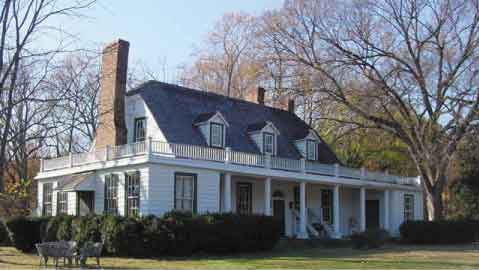Historic Preservation/Archeology in Prince William County:
Rippon Lodge
 Rippon Lodge was built about 1725 by architect Richard Blackburn,who also designed the original home at Mount Vernon. Perhaps the oldest house in Prince William, Rippon Lodge is located along the historic Potomac Path, originally an Indian trail that became one of the major transportation route linking northern and southern colonies. Today you can find Rippon Lodge about 0.8 miles North of the intersection of U.S. Route 1 and Route 642/Hoadley Road in Woodbridge, Virginia. Rippon Lodge was built about 1725 by architect Richard Blackburn,who also designed the original home at Mount Vernon. Perhaps the oldest house in Prince William, Rippon Lodge is located along the historic Potomac Path, originally an Indian trail that became one of the major transportation route linking northern and southern colonies. Today you can find Rippon Lodge about 0.8 miles North of the intersection of U.S. Route 1 and Route 642/Hoadley Road in Woodbridge, Virginia.
Rippon Lodge was added to the National Register of Historic Places on July 2, 1971, reference #71000988.
Prince William County purchased historic Rippon Lodge in 1999 for $1.4 million. The 2008-2013 Capital Improvement Program budget, Community Development section, shows yearly annual expenditures of $70,000 from the General Fund plus an additional $1,225,000 from a settlement with the federal government associated with development next to Manassas Battlefield National Park to help fund restoration efforts at Rippon Lodge. (Click here to read the U.S. Court of Appeals January 2002 opinion.)
In December 2003 the Planning Commission approved the subdivision plan submitted by developer D.R. Horton for 840 residential units on a parcel adjacent to Rippon Lodge. Although Prince William regulations require subdivision plans to show publicly owned land within fifty (50) feet (15.24 meters) of the property lines or additional distance, as may be necessary, in order to show major features or conditions that may affect the project [Administrative Procedures Manual, 4.05.3(B)], the adjacent County-owned Rippon Lodge was not included on the plan.
In spring 2004 developer D.R. Horton filed for final site plan approvals, based on the previous Planning Commission approval. At this time, the County initiated objections to the development proposal based on impacts to Rippon Lodge. D.R. Horton filed a court case and, in October 2004, the County agreed to a negotiated settlement. According to the newspaper articles on this topic, see below, the County agreed to allow construction of an additional 300 residential units in exchange for an expanded buffer and preservation of part of the historic Potomac Path.
The development plan that resulted from this negotiated settlement was approved by the Planning Commission at their December 15 2004 meeting. |
